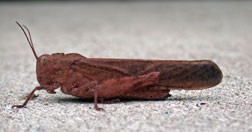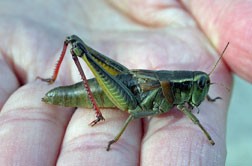The Grasshopper – Springboard Aerialist
- Share
- Tweet
- Pin
- Share

The Carolina Locust or Grasshopper is a master at catapulting. Photo by Roy Lukes.
Do you remember when you were a kid and you caught grasshoppers in late summer so you could make them spit “tobacco juice?” I can clearly recall my first whiff of that acrid, brownish, ill-smelling liquid.
These fond memories of late, lazy summer days will surely come back to me as soon as I get a fleeting glimpse of the first Carolina Locust of the season.
Just to jog your memory, the grasshopper with black wings having a yellow border along the front edge is called the Carolina Locust. The more I look at this droll-faced creature the more I marvel at especially its strong hind legs. These famous trademarks, its beautifully created legs, may have inspired the American Indians to invent the atlatl (AT-lat-l).
Our archeologist friend of past years, Edward Wells of Forestville, once demonstrated to us the use of an atlatl. This is a notched stick used by a spear thrower to greatly increase the speed, thrust and distance of a thrown spear.
Look closely at a grasshopper poised to jump and you will easily notice that the angle formed between the femur and tibia is extremely small. Suddenly within a fraction of a second, like a spring under great tension, the angle is increased to nearly 180 degrees as the hopper literally explodes away from its resting place.
The 2½-inch dull ashy brown Carolina Locusts that prefer warm dry locations, such as roads, dusty driveways or short-clipped lawns, fly quite erratically as they make their escape from close approach. It is the sudden appearance of the rather handsome black and yellow wings that startles people. The locust’s rattling, crackling, clattering flight, sometimes of considerable distance, also catches some folks off guard.
The black and yellow true wings are folded like a fan beneath strong, leathery, membranous “cover” wings that are bent downward at the edges to protect the flight wings. The thin cover wings are sometimes held quite stiffly upward in the air when the insect is flying. It is the edges of the two wings being rubbed together as the locust flies that produce the crackling noise, the so-called “music of flight.”
A Short-winged Grasshopper’s antennae are shorter than its body. This imposing creature belongs to a larger order, Orthoptera, the straight-winged insects. Included in this group are grasshoppers, katydids, cockroaches, mantids and walking sticks, all distinguished by having two long folds in the back wings.
Except for the cicada, nearly all the insect musicians are straight-winged insects. In most parts of the world the word locust designates grasshoppers that migrate in swarms.

The “collar,” or pronotum, shows clearly on this grasshopper. Photo by Roy Lukes.
Members of this large tribe go through a simple metamorphosis. Eggs are laid during the fall. The female forces her abdomen (tail tool) into the ground and lays a packet of about 20 eggs in this burrow, or pod, and can lay up to 20 pods. Each egg is about the size of a grain of rice. The pods are covered over with a gummy substance to protect them from “robbers.”
Strangely there can be reproduction through eggs that hatch without fertilization by a male. This process is called parthenogenesis (par-the-no-JEN-e-sis). The eggs develop and hatch normally into more females, so one generation of females after another frequently occurs.
The eggs hatch the next summer into what appear to be very miniature adults. These tiny creatures eat vegetable matter, grow and molt their exoskeletons. Each stage of their growth is called an instar.
Their wings develop externally during early instars and resemble tiny fans. Compound eyes also form during one of the first instars. These immature instars, called nymphs, resemble adults except in size, body proportions and wing development. Finally, after eight to 12 weeks, and after the last molt, the wings are formed and the grasshopper, or locust, is now capable of flying as well as jumping.
Strangely quite a few of the 600 or more species of these famous insects found in the U.S. are quite inoffensive and also non-migratory. Many kinds, however, are extremely destructive such as the swarming, migratory locusts. There are cases on record where great numbers flew high in the sky for long distances destroying most of the vegetation where they landed. A monument in Salt Lake City, Utah, pays tribute to the flocks of California Gulls that destroyed hordes of Mormon Crickets, a species of Long-horned Grasshopper, that were eating the crops of the early Mormons.
Young hoppers, before attaining the power of flight, can catapult a distance equal to about 20 times their body length. They, like the adults, have short front legs, somewhat longer middle legs, and hind legs nearly as long as their entire body. The femur, or upper part of a hind leg, contains powerful muscles to aid the creature in making its long vaults. The outer surface of the femur has a herringbone appearance and covers those amazingly strong braided-like muscles.
The tibia, compared to our shinbone, is long, strong, and quite rigid. Very sharp claws adorn the feet. Oval toe pads exist between and in front of the claws. These important pads contain microscopic hairs called tenet hairs. A sticky fluid is secreted from these pads enabling the grasshopper to cling to smooth surfaces.
A close look at the insect reveals large compound eyes set high on the head, giving the creature an innocent and solemn appearance. Unlike mammals’ and birds’ eyes, the amazing compound eyes have no lids and cannot be focused. Three simple eyes, one in front of each eye and another in the middle of the forehead, add to the grasshopper’s sight.
A collar-like piece, shaped like a sunbonnet, called a pronotum, forms a cover for the thorax and can be used to identify various species.

The heavily armored legs are often put to use by this Red-legged Locust. Photo by Roy Lukes.
Compared to crickets and katydids (quite the singers), the short-horned grasshoppers are not very good musicians. Their singing, done during the warmest part of the day, is accomplished by rubbing a hind leg on the forewing. Only males are “songsters.” Ears of the hopper, more properly referred to as organs of hearing, are little triangular objects next to the upper large end of their hind legs and are covered normally by their wings.
Even though the notorious grasshoppers are despised by most humans, don’t underestimate their importance as food to other animals such as frogs, snakes and birds. The American Kestrel (Sparrow Hawk) could very well be called the “Grasshopper Hawk” for they consume a hundred times more of these insects annually than all of the small birds they eat.
It would do all of us well to spend a portion of each day learning how to study, admire and respect some of our smaller partners in nature including these cosmopolitan masters of springboard dynamics, the grasshoppers.
